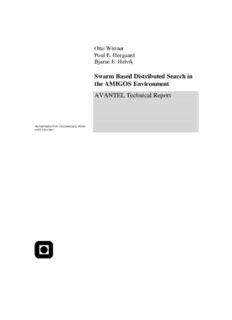
Swarm Based Distributed Search in the AMIGOS Environment PDF
Preview Swarm Based Distributed Search in the AMIGOS Environment
Otto Wittner Poul E. Heegaard Bjarne E. Helvik Swarm Based Distributed Search in the AMIGOS Environment AVANTEL Technical Report DEPARTMENTOFTELEMATICS,NTNU ISSN1503-4097 NTNU NorwegianUniversityof DepartmentofTelematics ScienceandTechnology AVANTELTECHNICALREPORT 1/2002 ISSN-no: 1503-4097 TITLE DATE Swarm Based Distributed Search in the AMIGOS 2002-12-09 Environment - NO.OFPAGES/APPENDICES 23(excl.titleandpreface) AUTHOR(S) Otto Wittner,PoulE.HeegaardandBjarneEHelvik ABSTRACT Futureusercontrolleddevelopment oftelecommunicationservicescombinedwithpowerfulterminal equipment resultsinmanyheterogeneousservicesrunninginapeer-to-peerexecutionenvironment.In suchasystemlocatingadesiredserviceischallenging.Inthispaperaswarmbasedoptimization algorithmispresentedcapableoffindingpathsofresourcesinacomplexnetworkenvironment.The algorithmisfullydistributedandmaybeimplementedusingsimpleant-likemobileagents.Onthe contraryto existinglocalizationmechanismsforpeer-to-peersystemsthealgorithmconsidersall accessedresourcesbetween(andincluding)theclient sideandserversidewhenaresourcepathis evaluated.Scalabilityisachievedbyenablingagentsto cooperateduringsearchwhentheyhave overlappingsearchprofiles.Resultsfromsimulationsarepromising.Theexpectedcooperative behaviorisshownto bepresent,i.e.aset ofnearoptimalresourcepathsconformingto aset of different but overlappingsearchprofilesmaybefoundwithout performancedegradation. KEYWORDS SwarmIntelligence DistributedSearch MulticriteriaCombinatorialOptimization Peer-to-Peer Amigos Preface Thistechnicalreport describesresultsfromresearchactivitieswithintheAVANTELproject. Thefirst authorofthisreport,Otto Wittner,wasengagedasresearcherfortheproject foraperiodof8months, ref.contract titled“Sverm-intelligensforoptimalkonfigurasjonavdistribuerteteletjenester”signed byItem,NTNU2001-01-07andTelenor2001-01-09.Adescriptionofthemajorresultsfromthe engagement followsthispreface.Thedescriptionispresentedintheformat ofapapersuitablefor publishinginaconferenceorajournal.OthercontributionsintheAVANTELproject madebythefirst authorareasfollows: • Development ofexampleuserscenariosforAMIGOS(seeAMIGOSdocument repository) • Development ofexampleprofiledescriptionsinXML.Profilesuggestionsforusers,services andterminalsweredeveloped(seeAMIGOSdocument repository). • Participationinmisc.meetinganddiscussionswherebasicconceptsandprincipleofthe AMIGOSserviceweretreated. Themajorresults,i.e.thepaperfollowingthispreface,isintendedto besubmittedto asuitable conferencebeforeendofJanuary2003. Swarm Based Distributed Search in the AMIGOS Environment OttoWittner,PoulE.HeegaardandBjarneE.Helvik December9,2002 Abstract Futureusercontrolleddevelopmentoftelecommunicationservicescombinedwithpowerfulterminal equipmentresultsinmanyheterogenousservicesrunninginapeer-to-peerexecutionenvironment. Lo- catingadesiredserviceinsuchanenvironmentischallenging.Inthispaperaswarmbasedoptimization algorithmispresentedcapableoffindingpathsofresourcesinacomplexnetworkenvironment.Thealgo- rithmisfullydistributedandmaybeimplementedusingsimpleant-likemobileagents.Onthecontraryto existinglocalizationmechanismsforpeer-to-peersystemsthealgorithmconsidersallaccessedresources between(andincluding)theclientsideandserversidewhenaresourcepathisevaluated. Scalability isachievedbyenablingagentstocooperateduringsearchwhentheyhaveoverlappingsearchprofiles. Resultsfromsimulationsarepromising.Theexpectedcooperativebehaviorisshowntobepresent,i.e.a setofnearoptimalresourcepathsconformingtoasetofdifferentbutoverlappingsearchprofilesmaybe foundwithoutperformancedegradation. Keywords Telecommunications,distributedoptimization,resourcepaths,ant-likeagents,peer-to-peer. 1 Introduction Asthenumberofusercategoriesandterminalequipmenttypesareincreasingsteadily,telecommunication operatorshaverecognizedapotentialforarangeofnewtelecommunicationservices.1Oneservicecategory, whichhasquicklygainpopularity,ispeer-to-peersystemswhereusersdevelopandprovideservicestoother userswithlittleornocentralizedmanagement. Usercontrolleddevelopmentofservicesquicklyproduce a large rangeof services where both the number of services and service categoriesare highly dynamic. Userswith powerfulterminalstaketheroleas serviceproviders,whileotherusersmay choseto initiate their services on dedicated servers in the network. The combinationof a dynamicset of services and a peer-to-peerenvironmentforserviceexecutionmakeslocatingarelevantservicechallenging. Manydirectorysystemsforpeer-to-peerenvironmentshavebeendevelopedduringthelastdecade[3]. Commonforthesesystemsarelimitedfunctionalityforspecifyingqualityofservice(QoS)parametersin servicelookuprequests.Inmostcasesonlysomeidentityoftheservicerequestedcanbespecifiedandvery few(orno)parametersindicatingminimumrequirementstoresourcesneededtoaccesstheservice. The resultisoftenanoveralluninterestingserviceoffer. Forinstancewhenrequestingamultimediastream, access to a high quality versionof the stream may beofferedbut dueto lack of network bandwidththe streambecomesuninteresting. Severalbio-inspiredalgorithmhaveshownpromisingresultswhenappliedtotelecommunicationrelated problems. A class of bio-inspired algorithms known as swarm intelligence systems [4] are potentially robust and may scaled well due the their use of distributed autonomous components. In this paper we presentaswarmintelligencebasedalgorithmwhichenablesimplementationofimprovedQoScontrolled servicelookupandaccess. Relatedworkonbio-inspiredmethodsforservicecomponentmanagementcan befoundin [5,6,7, 8,9]. Our algorithmexpectsa servicelookuprequestto containa profilewhichin additionto indicateconstraintsandpreferencesfor theservicetypebeingrequested,indicateconstraints andpreferencesforotherresourcesnecessarytoaccesstheservice. Thealgorithmseekstofindapathof resourcesfromaclientterminaltoaserviceprovidingserversuchthatallresourcesinthepathconforms (aswellaspossible)withtheconstraintsandpreferencesoftherequestprofilespecifiedbytheuser. 1Toenablerapidrealizationofnewheterogenousservices,Telenor,EricssonandNTNUhavechosentomovefromthetraditional callcentricapproachestoamoreservicecentricapproachaswellasinvolvingusersanduserinnovationintheservicedevelopment process[1].Peer-to-peerisadoptedasapotentialenvironmentfordistributedserviceexecution. Theoverallinitiativehasresultedin theAVANTELproject[2].ThispaperpresentsresultsformresearchsponsoredbytheAVANTELproject. 1 Ouralgorithmisbasedontheconceptofswarmintelligencewhichinheritsbehavioraspectsfromsocial insectsandanimals. Swarmintelligencehassuccessfullybeappliedtoarangeofoptimizationproblems [10],sometypicalinthedomainoftelecommunications[11,12,13,14]. Swarmintelligencesystemsuse a high number of simple autonomousagents to search for problem solutions. Groups of (or all) agents cooperateby sharing experiencesgained duringsearch. Informationis shared by asynchronousindirect communication,i.e.messages(pheromones)leftinshareddatabasesinthesearchenvironment. Ouralgorithmisbasedonworkpreviouslypublishedin[15,16,17]. Scalabilityintermsofnumber of parallel tasks handledby agentshas so far only been addressed to a limited extent. In this paper we introducesmechanismstomanagelargescaleuseofouralgorithm.Ontheassumptionthatservicerequest profilesinmanycaseswillbeoverlapping,i.e. containsimilarconstraintsandpreferences,weletagents shareinformationabouttheoverlappingpartsoftheprofiles. Assumingalimitedtotalnumberofpossible constraints and preferencesthe new sharing strategy reduces the total amount of storage space required forpheromonestoamanageablelevel,andincreasesthesearchefficiency. Tofindadesirablerankingof solutionscostfunctionswithimplicitconstraintsaredevelopedwhichoutputaqualitymeasureofhowwell apathofresourcesconformwithaprofilerequest. Thereminderofthispaperhasfivesection. Section2presentsbackgroundinformationandintroduces thesearchdomainwithrelatedterminologyandformalisms.Section3introducesthebehaviorfoundations for the agents, describes the cost functions which evaluates criteria during the search process, presents reformulationsandadditionsrequiredtorealizeextendedpheromonesharingbetweenagents,anddescribes thenewagentalgorithm.Section4describesourexperimentalsetupconsistingoffivesimulationscenarios, andreportsanddiscusssimulationresults.FinallySection6summarizeandindicatefuturework. 2 Resource Paths and Profiles Inthispaperweviewallcomponentsinanetworkenvironmentasresourceswithindividualprofiles,i.e. servicecomponents(createdbyusersoroperators)aswellaslinksandnetworknodesfornetworktransport areviewasresourceswitharelatedprofile.Anorderedsequenceofresourcesaredenotedaresourcepath. 2.1 Motivation The motivation for adopting a resource view is the heterogeneity of the expected network environment whereoneoftheAVANTELproject’srootservices,AMIGOS[1],isrunning. 2.1.1 AMIGOS AdvancedMultimediaInGroupOrganizedServices(AMIGOS)providesthebasicfunctionalityrequired for users to manage and visit a Meeting Place (MP). A meeting place is a user (or operator)composed andconfiguredtelecommunicationserviceprovidingaconnectionpointbetweenaspecificsetofusers. A meetingplacemayalsoactasarepositoryformultimediaobjectstobesharedbetweentheusersvisitingthe meetingplace. TechnicallyameetingplaceisasoftwareprocessrunningonsomeserverintheAMIGOS networkenvironment. 2.1.2 TheAMIGOSEnvironment Figure 1 illustrates the expected heterogeneity of the environment where the AMIGOS service will be running. Softwareprocesses provideMP service resourceswhich again providingaccess to multimedia objects. Amixofterminalscontrolledbydifferentusersandamixofserversownbydifferentoperators provide processing power. And finally a range of transmission technologies provide transmission links interconnectingterminalsandservers. BothterminalsandserversshowninFigure1aretypicallyconnected(bydifferenttransmissiontech- nologies)toseveralotherterminalsand/orservers,i.e. networknodesintheAMIGOSenvironmentoften haveaconnectiondegreegreaterthanone.Adegreegreaterthanoneenablesanodetoactasarouterora relayinadditiontoitsothercapabilities. Allterminals,usersandservicesintheAMIGOSenvironmentareexpectedtohaveindividualprofiles whichdescribetheircapabilitiesandlimitationsintheformofQoSparameters. Figure 1 does not illustrate the expected scale of the AMIGOS environment. The following rough estimationsindicateamorerealisticscaleconsideringpotentialusersinNorwayonly: 2 n o siti AY MP o L P R A MPEG lib GSM P UMTS POTS ISDN PS LAN P G S I Bluetooth LAN MIGOS MMMPPP Chat ADSL Bluetooth A Internet WLAN LAN Router MP MP Maps MP3 share Figure1:AexamplenetworkenvironmentwhereAMIGOSisexpectedtorun. (cid:0) Totalnumberofusers: (cid:1)(cid:3)(cid:2)(cid:5)(cid:4)(cid:7)(cid:6)(cid:9)(cid:8)(cid:11)(cid:10) (i.e.inthesameorderasthenumberofGSMsubscribers) (cid:0) Numberofsignificantlydifferentterminal/server/routertypes:(cid:1)(cid:3)(cid:12)(cid:13)(cid:4)(cid:14)(cid:6)(cid:15)(cid:8)(cid:11)(cid:16) (cid:0) Numberofnetworktransportservices:(cid:1)(cid:18)(cid:17)(cid:19)(cid:4)(cid:14)(cid:6)(cid:15)(cid:8)(cid:11)(cid:20) In the following sub-sections we establish formal terms for describing componentsin the AMIGOS environment. 2.2 ResourcePaths WeviewtheAMIGOSenvironmentasacompositionoftelecommunicationresources. Aresourceisde- noted (cid:21) . In a real instance of the environment,resources we consider will be only those which can be accessed,configuredandcontrolled(seeSection5fordetailsonimplementationissues). Whenusersareactiveinthenetworkenvironmenttheywillaccessasetofresources. Wedenotesuch anorderedsetofresourcesaresourcepath (cid:22)(cid:24)(cid:23)(cid:14)(cid:25) (cid:21)(cid:27)(cid:26)(cid:29)(cid:28)(cid:30)(cid:21)(cid:13)(cid:31)(cid:15)(cid:28)! ! ! "(cid:28)#(cid:21)%$%&(’ (cid:20) (cid:28)#(cid:21))$(cid:27)&(cid:11)’*(cid:31)(cid:15)+ (cid:1)(cid:3), where isthenumberofresourcesinthepath. Wehavechosentodividetheindividualresourcesfoundinapathintothreecategories:Client,Transport andPeripheralresources. Aclientresources, thefirst resource(cid:21))(cid:26).-0/21 in apath, enablesa userto access otherresourcesin the environmentby providinga suitable interface.Typicalclient resourcesare terminalsrunningclient applications(e.g.abrowser)./ 1 isthesetofallclientresources. Atransportresource, anintermediateresource(cid:21)(cid:13)3)-4/ (cid:12) where5 (cid:23) (cid:6)76!6869(cid:1) ,2:<; ,providesatransportser- viceofsomequality.Typicaltransportresourcesareinternalandexternaltransmissionlinks(clouds (cid:12) inFigure1)andnetworknodesactingasroutersorswitches. / isthesetofalltransportresources. Aperipheralresource thelastresource(cid:21)(cid:13)$%&=’*(cid:31)>-4/@? inapath,providessomevalueaddedservice.Users willnormallydesiretoaccessaspecifictypeofperipheralresource.Typicalperipheralresourcesare AMIGOSmeetingplaces,multimedialibraries,processingpower,multimediasensors,positioning sensorsetc. />? isthesetofallperipheralresources. 3 In our view access to minimum two resource will be required for any user activity, at least one client resourceandoneperipheralresource.Thus (cid:0)(cid:2)(cid:1)(cid:4)(cid:3)(cid:6)(cid:5)(cid:8)(cid:7)(cid:10)(cid:9)(cid:12)(cid:11)(cid:14)(cid:13)(cid:16)(cid:15)(cid:17)(cid:9)(cid:19)(cid:18)(cid:21)(cid:20)(cid:23)(cid:22)(cid:25)(cid:24)(cid:26)(cid:20)(cid:28)(cid:27)(cid:30)(cid:29) where(cid:20)(cid:31)(cid:22)! #"!$ and(cid:20)(cid:28)(cid:27)% #"’& Ingeneralaresourcepathwillonlycontainasingleclientandasingleperipheralresource,butmaycontain asequenceoftransportresources.Thus(cid:15) (cid:17)( where ()(cid:9)*(cid:18)(cid:25)(cid:18)+(cid:20)(cid:23)(cid:22),(cid:24)-(cid:20).(cid:27)/(cid:24)10(cid:21)0+02(cid:24)(cid:26)(cid:20).3(cid:23)46527,(cid:24)(cid:26)(cid:20)(cid:31)3(cid:23)4658(cid:27)+(cid:29):9.(cid:20)(cid:23)(cid:22)! (cid:6)"!$(cid:21)(cid:24);(cid:20)(cid:28)(cid:27)=<<<3(cid:31)465>7? #"%@A(cid:24);(cid:20)(cid:31)3(cid:23)4B52(cid:27)% (cid:6)"C&D(cid:29) isthesetofallresourcepaths.(cid:5) (cid:7)E (cid:18)/(cid:11) (cid:24)DFD(cid:24);GH(cid:24)1I1I(cid:21)I(cid:29) isthetotalnumberofresourcesinapath. Acommonlimitationoftoday’slookupservicesforpeer-to-peersystemsisthatthecompleteresource pathrequiredtoaccessaperipheralresourceisnottakenintoaccountduringsearch. Informaltermsthis meansignoringthe sub-path (cid:18) (cid:20)(cid:31)(cid:22)6(cid:24)(cid:26)(cid:20)(cid:28)(cid:27)+(cid:24)1010108(cid:24)-(cid:20)(cid:31)3(cid:23)4(cid:25)5 7 (cid:29) or parts of it. Our algorithmin this paper takes into accountthecompletepathofresources,i.e. (cid:18) (cid:20).(cid:22),(cid:24)-(cid:20)(cid:28)(cid:27)(cid:30)(cid:24)+0(cid:21)0102(cid:24)(cid:26)(cid:20)(cid:31)3(cid:31)4B5 7 (cid:24)(cid:26)(cid:20).3(cid:23)4652(cid:27)(cid:30)(cid:29) . 2.3 ProfilesandQoSObjectives IntheAMIGOSenvironment,users, terminalsandservicesareexpectedtohaveindividualprofilescon- MON(cid:25)P tainingQoSparameters. Whenauser J initiatesarequestsK foraservice,auserrequestprofile L J;Q is generated. Foraresource(cid:20)(cid:28)R intheenvironmentwedenote MHL P(cid:20)(cid:31)R Q theprofileoftheresource. Thusthere aretoclassesofprofiles: S ProfilesoftheuserrequestclasscontainQoSparametersspecifyingconstraintsandpreferencesin therequest,i.e.QoSobjectives. S Profiles of the resource class contain QoS parameters specifying limitations and capabilities of a resource(cid:20) R . 2.3.1 UserRequestProfile Ingeneral,auserrequestprofilemayincludealargesetofQoSparameters. Tomaintainscalability,we have defined a finite and ordered set T of QoS objectives from which a specific request profile may be constructed.EachelementU+V inT ,whereW (cid:9)YX (cid:24)+IZIZI(cid:4)(cid:24)+[T [,isaspecificQoSrequirement,e.g. S U1\ (cid:24) I(cid:21)I1I (cid:24) UO] maybearangeofmaximumendtoenddelaysof(cid:18)(cid:30)^ \ (cid:24) I(cid:21)I+I (cid:24) ^ ] (cid:29) seconds, S U N (cid:24)1I1I1I(cid:21)(cid:24) U1_ maybearangeofminimumbandwidthof(cid:18)(cid:30)‘ N (cid:24)+I(cid:21)I1I(cid:21)(cid:24) ‘ _ (cid:29) bits/s, S U1a (cid:24)1I1I(cid:21)I1(cid:24) U(cid:21)b maybespecifictypesofresources(cid:18)(cid:30)c a (cid:24)(cid:21)I1I1I1(cid:24) c b (cid:29) ,e.g.typesofperipheralequipment. AuserrequestprofilemaynowbeexpressedasMLN PJ;Q (cid:9)d(cid:18)(cid:30)e (cid:27)/(cid:24) I(cid:21)I1I (cid:24) egfhif(cid:29) .Inthisinvestigation,abinaryuser requestprofileisused,i.e., e (cid:9)kj Xl9 whenrequirementW shouldbemet V m 9 otherwise howeverin general(Section 3.3)arbitrary values e V(cid:8)n m may be used to balancetheimportanceof the variousrequirements. InthecaseswherewehavearangeofQoSparametersofthesamekindtochoosefrom,e.g.thedelays andbandwidthsabove,onlyonevalueintherangeshouldbeset. 2.3.2 ResourceProfile When used, a resource (cid:20) R may introduce QoS impairments with respect to the QoS requirements of a userrequestK(cid:30)\ . Theseimpairmentsmayforinstancebeexcessivedelays,limitedbandwidth,processing or storage capacity, or lack of required peripheralequipment, services or information. Impairments are denotedtheloss o V P(cid:20) R Q introducedbyresource(cid:20) R withrespecttoaQoSparameterW intheuserrequest profile.Hence,theresourceprofileMHL P(cid:20) R Q associatedwithresource^ isrepresentedasalossvector M;P(cid:20) R P(cid:20) R (cid:9)d(cid:18) (cid:27) P(cid:20) R (cid:24) 7 P(cid:20) R (cid:24) I(cid:21)I+I (cid:24) fhifP(cid:20) R (cid:29) L QqproL Q o Q o Q o Q 4
Description: